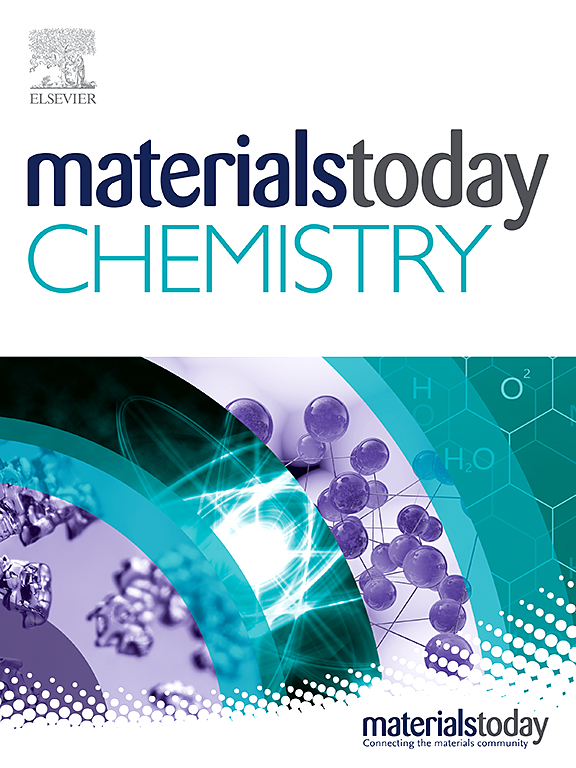Regulation of molecular conjugation to realize mult-color room temperature phosphorescence of carbon dots in urea and ammonium pentaborate precursor matrices
IF 6.7
2区 化学
Q1 CHEMISTRY, MULTIDISCIPLINARY
引用次数: 0
Abstract
Carbon dots (CDs) room temperature phosphorescent (RTP) materials have great application prospects in optoelectronic devices, advanced anti-counterfeiting, information encryption and bio-imaging due to its excellent optical properties. However, achieving long-lifetime phosphorescence with color-tunable RTP CDs is a huge challenge. In this work, precursor molecules with different degrees of conjugation: 4-ethoxycarbonyl phenylboronic acid (4-EpBA), 9-phenanthracenylboronic acid (9-PhBA) and 1-pyrenylboronic acid (1-PyBA) were combined with urea and ammonium pentaborate (AP) matrix through high temperature pyrolysis method, long-lifetime and colorful phosphorescent CDs composites of 4-EpBA@Urea, 9-PhBA@Urea and 1-PyBA@AP were successfully synthesized. As the degree of conjugation of the precursor molecules increased, the phosphorescence colors of 4-EpBA@Urea, 9-PhBA@Urea and 1-PyBA@AP were blue, green and orange, respectively. In addition, since 1-PyBA@Urea could not produce orange phosphorescence emission, we chose 1-PyBA@AP that was able to generate bright orange phosphorescence after UV excitation. Furthermore, the rationality behind phosphorescence emission mechanism and wavelength modulation is further conformed by density functional theory (DFT) calculations. Finally, RTP CDs composites are successfully applied for advanced anti-counterfeiting and optical information storage.调节分子共轭,实现尿素和五硼酸铵前驱体基质中碳点的多色室温磷光效应
碳点(CD)室温磷光(RTP)材料因其优异的光学特性,在光电器件、高级防伪、信息加密和生物成像等领域具有广阔的应用前景。然而,实现可调色 RTP CD 的长寿命磷光是一项巨大的挑战。在这项工作中,前体分子具有不同的共轭程度:通过高温热解方法,将4-乙氧羰基苯硼酸(4-EpBA)、9-菲硼酸(9-PhBA)和1-芘硼酸(1-PyBA)与尿素和五硼酸铵(AP)基质结合,成功合成了4-EpBA@尿素、9-PhBA@尿素和1-PyBA@AP的长寿命彩色磷光光盘复合材料。随着前驱体分子共轭度的增加,4-EpBA@Urea、9-PhBA@Urea 和 1-PyBA@AP 的磷光颜色分别为蓝色、绿色和橙色。此外,由于 1-PyBA@Urea 不能产生橙色磷光,我们选择了在紫外激发后能产生明亮橙色磷光的 1-PyBA@AP。此外,密度泛函理论(DFT)计算进一步证实了磷光发射机制和波长调制的合理性。最后,RTP CD 复合材料被成功应用于先进的防伪和光信息存储领域。
本文章由计算机程序翻译,如有差异,请以英文原文为准。
求助全文
约1分钟内获得全文
求助全文
来源期刊

Materials Today Chemistry
Multiple-
CiteScore
8.90
自引率
6.80%
发文量
596
审稿时长
33 days
期刊介绍:
Materials Today Chemistry is a multi-disciplinary journal dedicated to all facets of materials chemistry.
This field represents one of the fastest-growing areas of science, involving the application of chemistry-based techniques to the study of materials. It encompasses materials synthesis and behavior, as well as the intricate relationships between material structure and properties at the atomic and molecular scale. Materials Today Chemistry serves as a high-impact platform for discussing research that propels the field forward through groundbreaking discoveries and innovative techniques.
 求助内容:
求助内容: 应助结果提醒方式:
应助结果提醒方式:


